Yes, it's a |
1954
Chevrolet Convertible |
Even better, it was sold when
new, with every power option offered in 1954. |
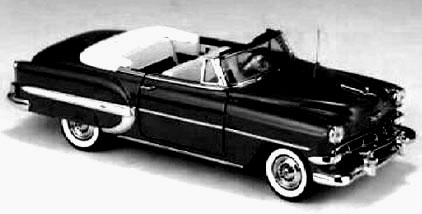
| A Frame-Off Restoration, (A labor of love, 30 years in the making.) |
|
 |
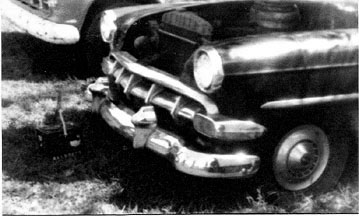 |
The top had holes in it and we chose to put it down, (so we could look "so cool.") As we drove home, Leaves, dust and dirt blew up around us on the wind and out of the car in a cloud... But WE were "cool." |
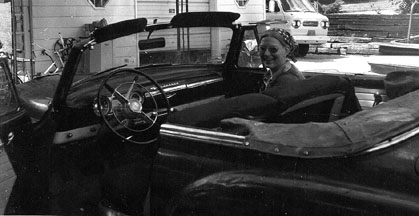 |
Our 1954 Chevrolet Bel-Air Convertible had set for many years, having only been driven 39,xxx miles. It had rusted badly from sitting under an oak tree on a farm. The Convertible was purchased in 1975 from my uncle Bob who had gotten it from the farm, with no reverse gear on the powerglide, it was quite a find for him and later for me. A charge of the battery was all it needed. It started right up and we drove it home. The most impressive thing about this car, other than its rare body style, was that it was sold, when new, having every power option available from the Chevrolet Dealer in 1954. There was Power windows, seat, top, steering, breaks, head lights, radio and many more. in the photo on the right Rose can be seen riding shot-gun the day we took our new car home. A year later the car was totally apart and in boxes. That is when the marathon restoration started. If it is true what THEY say, "The devil IS in the details," THEY must have never figured four kids into the mix, We sure didn't. This restoration has been waiting for the kids to get out of school. Even though it could not be finished at one time, the restoration has continued, a little at a time, ever since the year 1976. This page of images show how much steady progress and work has gone into the restoration. |
| The Body |
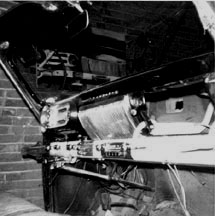 |
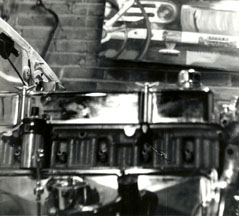 |
|
| In 1976 while still in college the car was on the road to it's restoration. My graduation from Washington University and wedding to Rose, stopped it cold and it went into storage. The first two images show progress. The next great leap into the restoration came in 1986, when it was brought to the studio for a cleaning and new assessment . (The little boy is "number-one son Gus," who is now 23 years old.) Two years later his little brother, Tom, was born and restoration slowed again. |

|
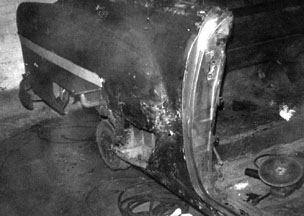 |
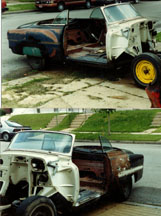 |
As said before, where the car was stored for years, there were many oak trees and it's top had been damaged by falling branches. Leaves piled-up inside it and caused the floor to rust badly. The rear wheels also sunk in the mud which rotted the quarters. The photos above show the damaged quarter panels, the passenger side was much worse than the drivers. In the late 80s, a trip was made to Colorado to purchase two rust free quarter panels. After they were welded into place, the body was removed from the frame and it was bolted to a stand that rotated it, so it could be worked on easier. The these four photos show the damaged panels and one of the new quarters welded in place. At this point the frame had not been removed for its restoration. |
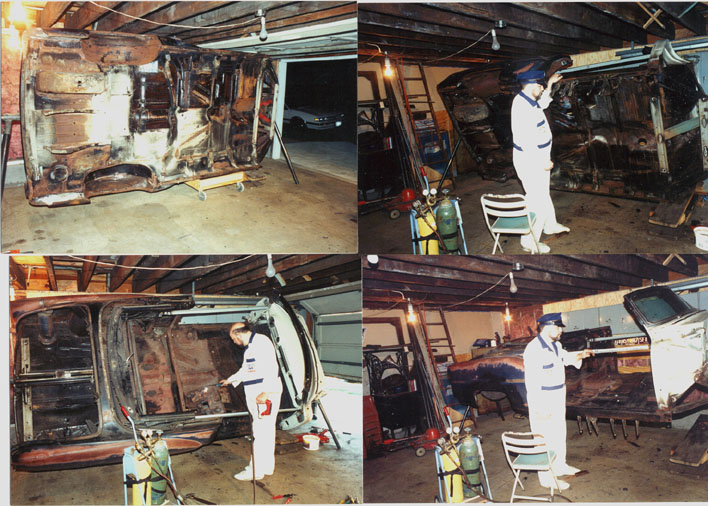 |
| This series of four images show the convertible's body bolted to a home built rotisserie. It was built to aid in the body restoration. The entire body can be seen here as it is turned totally around to accomplish any task necessary for its restoration. When the bottom of the body is finished it will be re-united with the finished frame and drive line assembly. |
| The Frame |
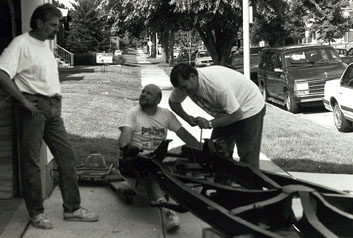 |
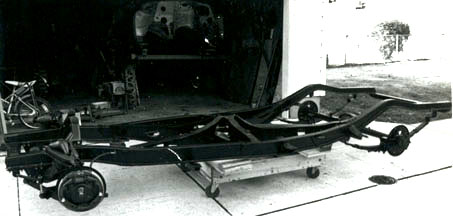 |
When the body was removed, the frame
taken apart and was sent out to be sand blasted, primed and painted.
It is seen here being re-assembled with the assistants
of friends. This image shows Hugh & Greg helping put it back together.
After the frame was on tires again it had to await the body, motor and
transmission assemblies. Even though all of the necessary parts had been
found, the motor and transmission had not been built yet. The frame had
to go back into storage again. |
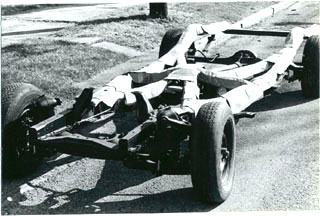 |
To keep the frame protected in storage, the frame was covered with strips of cardboard and was put into a storage garage to await the new motor and transmission. It would take another two years before it could be worked with again. During this down-time however the stock Chevrolet wheel rims were blasted, painted and the same as the frame. A new set of four US-Royal wide white-wall tires were ordered. |
The Engine |
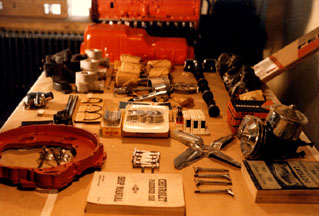 |
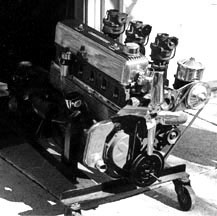 |
The engine is the heart of the car and was one of the last major parts to build. Having it together too early might be harmful. When the body and Frame were on there way the motor was next. Every cast part had been cleaned and painted and many bolt-ons had been sent out along time ago to be chrome plated. A roll-a-round stand was welded together to hold the full engine & transmission and to allow for it to be started if necessary. The block was bored 60 thousands over standard, to fit 9.5:1 compression "Jan's" pop-up racing pistons. Other items collected for the engine were a 1954 Corvette cam shaft & duel exhaust manifold, Mallory-duel point distributor, Offenhouser-tri-power manifold (with 3 down draft Rochester carburetors,) Chevy/Wayne-aluminum valve cover & side plate and Aluminum timing gear. Over many years I was also able to locate and purchase every Kent-Moore Powerglide tool made to aid in building my new transmission. My Powerglide operates right up to standards, as seen on the Kent-Moore transmission test gages in image three below. |
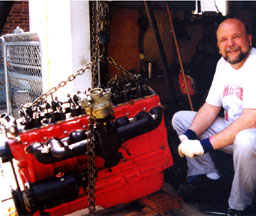 |
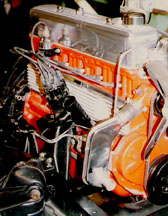 |
 |
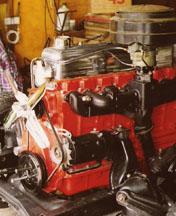 |
When the engine & transmission
were assembled, they were placed into the chassis, which had been removed
from storage and it was started for the first time in 23 years. A radiator
was put on the assembly and it was then driven around the neighborhood
to test both the Stove-Bolt, 235 Engine and my personally built Power-glide
transmission. |
| These photo of fully assembled chassis were taken before a radiator was installed and we had our test drive. |  |
My youngest son Tom, at 8, sits in A make-shift drivers seat and dreams of being 16 with a drivers licence. | 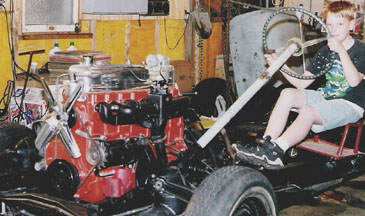 |
| Blasts From The Past (My Other Car Projects) |
The convertible was not the first 1954 Chevy restoration. In these images, taken in 1970s, you can see a much younger and thinner person with much longer, but thinning hair, restoring our very yellow 1954 tudor sedan, "LaBamba." This chevy restoration was also a frame off and many custom touches were added to the mix. |
These personal touches included: Black
Roll & Pleated Interior, Rally Sport Wheels with Rings and Centers
, L60-15 Mickey Thompson Rear Tires, Open Drive Line, Power Steering,
Power Breaks,Air Conditioning, Tinted Glass, AM/FM/8-track Radio, Duel
Tunneled Power Antennas. |
| Here I stand enjoying a vintage size Coke and feeling right out of the 1950s. This uniform was a Christmas gift from my wife and was bought to protect my clothes while working in the garage on the Convertible. |  |
The Studio Coke machine, a Vendo-39, was a graduate school, graduation gift, from my friends. It was a machine I personally used as a small child, and I remembered getting a soda from it for six cents. It was abandoned in the old neighborhood store front where I had operated it many years earlier. |
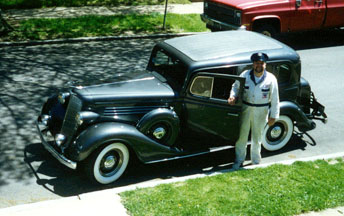 |
This 1935 Buick, series 40, was involved in an electrical fire due to cloth covered wires in very poor condition. The Studio install a full new 12 volt electrical system to get it back into operation. All of the cloth wiring was removed and a full new wiring harnesses was hand built. The car was also fitted with a blinker system and all the exterior lights were given new light sockets. This included modern small type halogen headlights that were incorporated the existing 1935 headlight parts. |
| I no longer own this car, but in 1973, I sectioned this 1957 Chevy Station Wagon to a wheel base of 86 inches. It was set-up for a 235, 6 cylinder engine, but the new owner installed a 350ci engine into it. I'm sure it can get a bit squirrelly. That is simply too much horse-power and too little total car weight. | 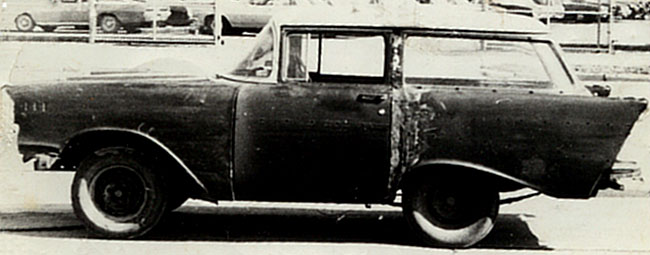 |
(Rev.02-2006)
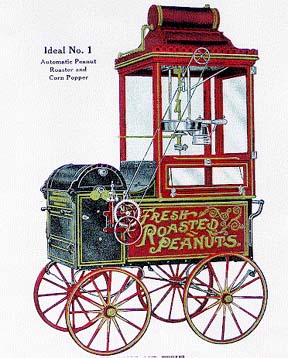 |
Click
on the "Popcorn Wagon" Icon to link to
view material on another mechanical project |
 |
Click
on the resume" Icon to return |
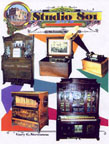 |
Click
on the "Home Page" Icon to return to the "Studio801"
home page |